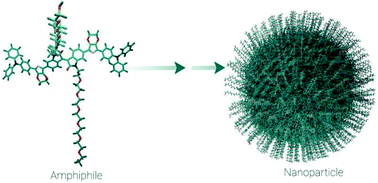In this work, we have taken a donor–acceptor–donor (D–A–D) fluorophore (II-EDOT-TPA) and encapsulated it using a linear dendritic block copolymer (LDBC). In parallel, a polyethylene glycol derivative (PEG-II-EDOT-TPA) was synthesized. The self-assembly and colloidal properties of both nanoaggregates were comparatively assessed. Photophysical and morphological characterization of the LDBC encapsulated II-EDOT-TPA and PEG-II-EDOT-TPA nanoaggregates was performed, which showed the photophysical and morphological properties differed greatly when comparing the two. Both nanoaggregate types were incubated with HEK-293 cells in order to measure cell viability and perform confocal fluorescence microscopy. Minimal cytotoxicity values (<20%) were seen with the two nanoaggregate forms, while both types of nanoaggregates were found to accumulate into the lysosomes of the HEK-293 cells. This work provides fascinating insights into NIR fluorophore design and methods to effectively alter the photophysical and morphological properties of the nanoaggregates for bio-imaging purposes.
